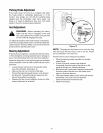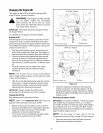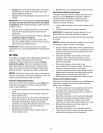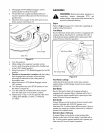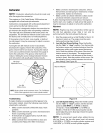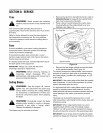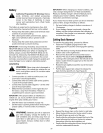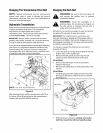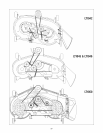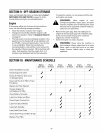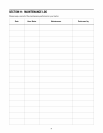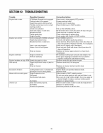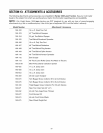
Battery
California Proposition 65 Warning: Battery
posts, terminals, and related accessories
contain lead and lead compounds, chemicals
known to the State of California to cause
cancer and reproductive harm. Wash hands
after handling.
The battery is sealed and is maintenance-free. Acid
levels cannot be checked and fluid can not be added.
• Always keep the battery cables and terminals clean
and free of corrosive build-up.
• After cleaning the battery and terminals, apply a
light coat of petroleum jelly or grease to both
terminals
• Always keep the rubber boot positioned over the
positive terminal to prevent shorting.
IMPORTANT: If removing the battery, disconnect the
NEGATIVE (Black) wire from it's terminal first, followed
by the POSITIVE (Red) wire. When re-installing the
battery, always connect the POSITIVE (Red) wire its
terminal first, followed by the NEGATIVE (Black) wire.
Be certain that the wires are connected to the correct
terminals; reversing them could change the polarity and
cause damage to your engine's alternating system.
JumpStarting
WARNING: Never jump start a damaged or
frozen battery. Be certain the vehicles do not
touch, and ignitions are off. Do not allow cable
clamps to touch.
• Connect positive (+) cable to positive post (+) of
your tractor's discharged battery.
• Connect the other end of the cable to the (positive
+) post of the jumper battery.
• Connect the second cable (negative -) to the other
post of the jumper battery.
• Make the final connection on the engine block of
the tractor, away from the battery. Attach to a
unpainted part to assure a good connection.
IMPORTANT: If the jumper battery is installed on a
vehicle (i.e. car, truck), do NOT start the vehicle's
engine when jump starting your tractor.
• Start the tractor (as instructed on page 13).
• Set the tractor's parking brake before removing the
jumper cables, in reverse order of connection.
Charging
WARNING: Batteries give off an explosive
gas while charging. Charge the battery in a
well ventilated area and keep away from an
open flame or pilot light as on a water heater,
space heater, furnace, clothes dryer or other
gas appliances.
IMPORTANT: When charging your tractor's battery, use
only a charger designed for 12V lead-acid batteries.
Read your battery charger's Owner's Manual prior to
charging your tractor's battery. Always follow its
instructions and heed its warnings.
If your tractor has not been put into use for an extended
period of time, charge the battery as follows:
1. Set your battery charger to deliver a maximum of
10 amperes.
2. If your battery charger is automatic, charge the
battery until the charger indicates that charging is
complete. If the charger is not automatic, charge for
no fewer than eight hours.
CuttingDeckRemoval
To remove the cutting deck, proceed as follows:
• Place the PTO/Blade Engage knob in the
disengaged (OFF) position and engage the parking
brake.
• Lower the deck by moving the deck lift lever into the
bottom notch on the right fender.
• Remove the deck belt from around the tractor's
electric PTO clutch (refer to Changingthe BeckBelt).
• Looking at the cutting deck from the left side of the
tractor, locate the deck support pin on the rear left
side of the deck.
• Rotate the pin slightly toward the rear of the tractor
and release it.
• Pull the deck support pin outward to release the
deck from the deck lift arm. See Figure 20.
!
Figure 20
• Repeat the above steps on the tractor's right side.
• Move the deck lift lever into the top notch to raise
the deck lift arms up and out of the way.
• Gently slide the cutting deck toward the front of the
tractor allowing the hooks on the deck to release
themselves from the deck stabilizer rod.
• Gently slide the cutting deck (from the right side)
out from underneath the tractor.
26



